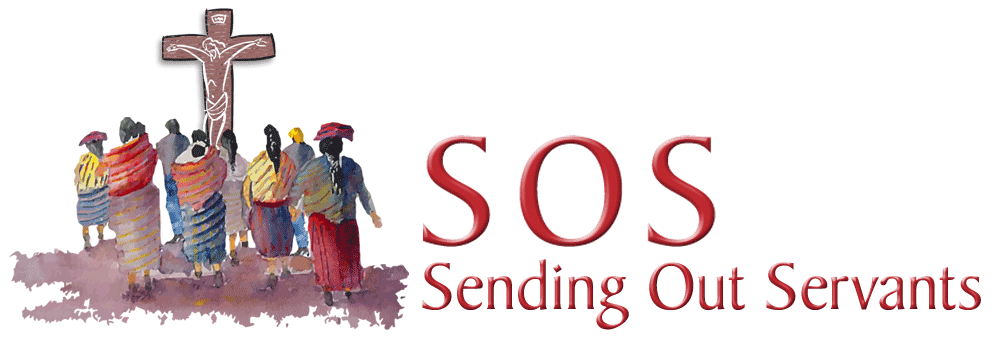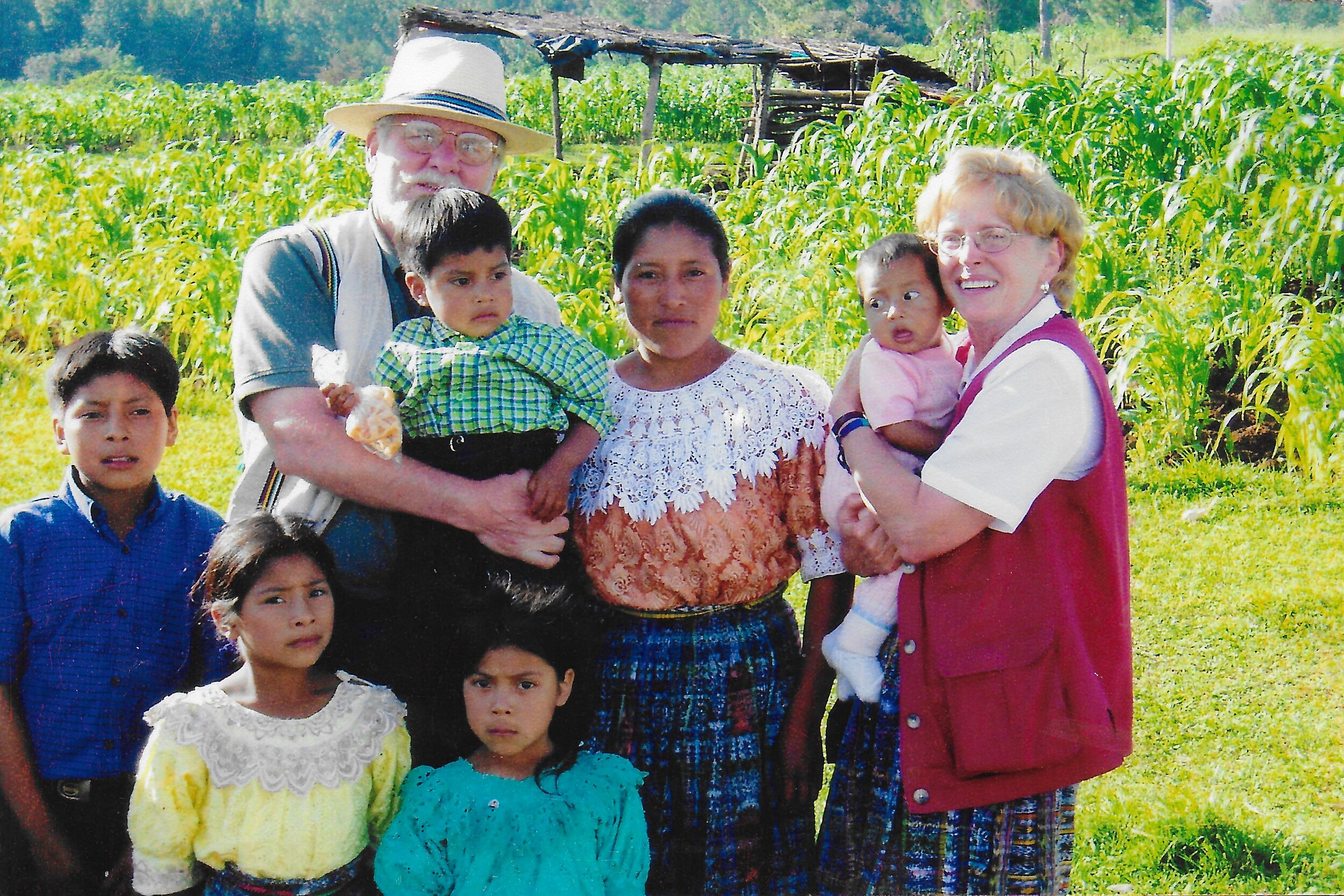
The Awakening
How Sending Out Servants (SOS) Began
by Connie Braren
“Faith never knows where it is being led but it loves and knows the one who is leading.”
2015 Vision Mission Trip - Joyabaj
My husband, Ernest, and I are frequently asked, “How in the world did you ever become involved in Catholic lay mission work?” How did you learn to form teams and take them to Guatemala?” To answer the first question quite honestly and simply, it was because God asked it of us. As a result of our lives being funneled down paths not of our own choosing, we came to know without a doubt that we were being asked to awaken the Catholic laity to the great need for their presence in Guatemala. And to answer the second question, we realized in hindsight that God had been encouraging us for some time to take ‘baby steps’ toward leadership roles and inconspicuously teaching us ‘the logistical ropes’ in preparation for the task He would eventually ask of us. Let me explain. In 1996, I was invited to participate in a weeklong ecumenical Medical Mission to Santa Cruz Del Quiché in the Highlands of Guatemala. At that time in my life, it was a daring step and I recall the variety and numerous fears that surprisingly surfaced. To go on a foreign mission with people I didn’t know, of other faith denominations, in a country far away, speaking a language I did not know, to not know for sure what I would be doing when I got there, to put it mildly, required a terrifying leap of faith and a quantity of courage beyond my human capacity. Defying all inner resistance, I accepted the invitation.
In preparation for that initial mission trip, there were team meetings. I deeply wanted my husband to join me in this experience, but he firmly declined. However, because of my inability to drive safely at night, he very willingly drove me to the evening meetings. What happened next surprised us both. At the meeting, a photo album from a previous years trip was passed around and as my husband viewed it, he became quite excited. It so happened that in recent years he had developed a passion for watercolor painting. When he saw all the beautiful scenery in the photos and the brilliant colors in the traje, the dress of the Mayan women, he began to think that he would go on the mission trip and just slip away and paint somewhere. So he signed up for the trip with his watercolors buried deep in his suitcase. We laugh now about how clever the Holy Spirit was in enticing him for He knew exactly what would attract him.
The scary day came when we had to surrender our fears to Our Lord and board the plane for the two and a half hour flight to Guatemala City and the four-hour bus ride on a ‘chicken bus’ over the mountains to Santa Cruz Del Quiché where the indigenous Maya live. The first day into the trip, to my astonishment and chagrin, after all that I had to overcome spiritually and psychologically, I became the only person in a team of forty-five who became mysteriously ill. I say mysteriously because this was not the common ‘travelers’ ailment. Plus I am very seldom ill even with colds. I spent the entire mission adventure confined to bed. Meanwhile, Ernest quickly fell in love with the Maya children and once into his non-medical assigned task, he abandoned all thoughts of watercolor painting. My condition did not improve and finally after receiving several units of intravenous fluid replacement, I was evacuated by a mission plane so that I could return home.
All during my forced rest and for many months after my return home, I was greatly puzzled as to why the Lord put such a strong desire in my heart to not only go on this mission, but also the courage to do so. At one point I concluded that it must have been my husband who He was pursuing and that He used me to get him there. “Well Lord”, I found myself often saying unconvincingly, “Whatever You want.”
The next year we were again asked to join the ecumenical Medical Mission team. We both eagerly signed up. Some things, I figured, need more than one try. This time on our first mission day in Guatemala, Ernest worked on a carpentry job while I reported to the hospital area. Another surprise awaited me. My assigned task was given to someone else so I had no job. I wondered again to the Lord, “What am I doing here? I don’t get it.”
Connie’s Birthday Celebration on the 2020 Vision Trip - Joyabaj
Shortly thereafter, one of the Team Leaders informed me that she wanted me and another nurse to fly by a small plane further north to investigate possible medical support at a new clinic being opened by Fundamentalist missionaries in the area. [More fears! I don’t like small planes with only two engines that feel and sound like they are going to break apart in mid-air.] But off I went nevertheless, only this time with an overwhelming keen sense that God wanted me to see something. Over and over again during the plane ride I whispered to Him “What is it You want me to see, Lord?”
The little plane landed in a cornfield. An amiable Fundamentalist missionary was waiting for us in a pickup truck and drove us through the little town of Canila. It was a small dusty dirt road town where men rode horses and dressed like cowboys with cowboy hats, chaps and spurs. We passed a prominent but abandoned looking building in the center of town. Responding to my question about it, the missionary said it was the Catholic mission church. It struck me in a sad way. It was so desolate looking. I wondered why it looked so abandoned, so dead and wondered how often a priest came.
2020 Vision Trip - Joyabaj
We drove to the Fundamentalist mission site that was on the outskirts. It was brimming with activity. Many Maya mothers were bringing their children to the clinic. The missionaries showed us the site where a new two-story building was going to be built by teams of people from the States coming that summer. The building would be used to hold nutrition and bible study classes. The missionaries planned to go by horseback up into the mountains to teach the Gospel. On and on they excitedly explained about all that they were doing in that community for the people. And then I saw what it was that I was to see. Rather, I saw what wasn’t to be seen – a total lack of a Catholic lay presence. Where were our Catholic men, women and youth? Who was helping the priest minister to our Catholic faith family in this remote village? Why were there so many Fundamentalist, Evangelical, Pentecostal brothers and sisters so enthusiastically serving our Lord in Guatemala while their Catholic counterparts were nowhere to be seen? Why is it that the Catholic laity are not here? I concluded that we are terribly, terribly asleep. At that moment, I wanted to immediately return home and start knocking on doors to tell my Catholic faith family to wake up. Wake up! You are needed! Come quickly! The priests need you! The Maya need you! Your faith family in Guatemala needs you! God needs your help! Those were my initial heart racing thoughts. Throughout the remaining time that Ernest and I spent on that mission trip, we began to ask a lot of questions and began to comprehend not only the reality of life for the Maya in Guatemala but also learn of some of the challenges for the Catholic Church.
Connie & Ernest getting to know the Maya
We were dramatically struck by what we learned, namely that
during the 36year-long civil war, the Maya were targeted for genocide with over 200,000 killed, over 100,000 disappeared and over 400 villages totally destroyed;
during this time, many catechists, priests and religious sisters as well as many Maya Catholic leaders were either tortured, killed or suddenly disappeared. Convents and Catholic churches were used as places for torture and killing.
in the height of the persecution the Quiché Diocese was closed down for three years as priests and religious were instructed by the bishop to leave the country or go into hiding;
this action was perceived by the people as the Church abandoning them in a time of great trial and persecution.
the people were being ministered to however, by Fundamentalist and Evangelical groups who successfully were attracting Catholics to their sect;
In the 1950’s, Guatemala became a pilot test country for Central America. The plan of American businessmen was to flood the country with Evangelical and Pentecostal sects with the hopes of decreasing the Catholic population and therefore influence it was having on teaching the Maya how to read and write, and stand up for their rights to regain the land that was taken from them by American businesses as well as other foreign businesses;
as a consequence of the above plan, Guatemala which was almost totally Catholic in the 1950’s was now 50% Catholic and still in a decline;
there was a conspicuous lack of a Catholic lay missionary presence amongst so many other denominational missionaries;
the priests needed help in ministering to the many Maya who lived in remote areas who only saw a priest once or twice a year, and;
last but certainly not least, we ourselves experienced a tremendous spiritual impact from the mission trip. We realized that the Catholic laity needed to be awakened and given an opportunity, a vehicle through which to put their faith into action in a way not opened to them in the past. In other words, to go to the mission field, share their faith and be evangelized by those they came to serve.
We returned from that particular mission trip in June of 1997. In July, Ernest and I approached Fr. Tom Ponzini with what we believed to be a calling from God - to form a short term Catholic lay mission organization for developing a long-term relationship with a parish in Guatemala.
Fr. Tom was then the Parochial Vicar of Prince of Peace Catholic Community in Houston, Texas. Unknown to us was the fact that the Holy Spirit was preparing and moving him as well in the same direction. For when we approached Fr. Tom, he whole-heartedly agreed with the idea. He saw it as a way to strengthen the whole parish community of Prince of Peace by involving all the parishioners in the mission outreach through Eucharistic Adoration prayer support. Fr. Tom saw also the mission outreach as a way to build a bridge between the Spanish-speaking faith community and the English-speaking. In other words, this missionary outreach was not to be a separate ministry of a few people but rather a parish mission with the whole parish responding to a common call to reach out beyond traditional parish borders – a call to be truly catholic.
Since that initial period of responding to this undreamed of and unimaginable call to missions, Ernest and I have been on one great big adventure with the Lord. It is truly a blessing and a grace beyond measure when one follows Him beyond fears, doubts and perceived limited abilities. Because only then, as we have learned, does one truly walk by faith. And in walking by faith, encounter a Personal and Living God.





